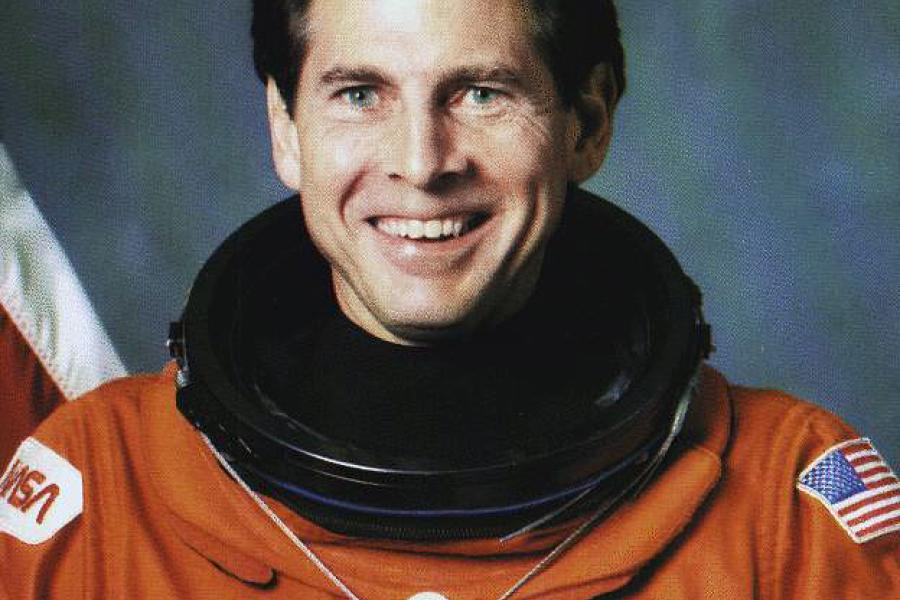Samuel Thornton Durrance, an astronomer who flew on two NASA space shuttle missions as a payload specialist, and who was a principal research scientist in the Department of Physics and Astronomy at Johns Hopkins University from 1980 to 1997, died on May 5. He was 79.
Durrance came to JHU in 1980 as one of the first team members on the Hopkins Ultraviolet Telescope, or HUT, project led by Professor Arthur Davidsen. HUT had been selected for development by NASA in 1978, with the intent of making multiple flights on the space shuttle. Durrance was a key player in the construction and testing of HUT and in 1984 was selected as one of two payload specialists to fly with the telescope on the Astro-1 mission. Preparations and training took Durrance away from JHU for long periods, but his returns were always exciting times for his JHU colleagues to get caught up on his latest activities and to provide status updates on HUT's instruments, most of which were developed on the first floor of the Bloomberg Center for Physics and Astronomy.
"I remember one trip back where Sam had a cutting-edge NASA 'laptop' in tow, only available to astronauts," says research professor Bill Blair, who was also part of the HUT team. "It was about 14x18 inches, 2 inches thick, and weighed about 10 pounds! It was the first time any of us had seen a 'portable' computer!"
Originally slated to launch in March 1986 to view Halley's comet, the mission was scrubbed when the previous flight in January 1986, involving the space shuttle Challenger, exploded shortly after liftoff. The Challenger tragedy put future shuttle flights on indefinite hold and caused real concern about whether HUT would ever fly.

In the down time after the Challenger disaster, Durrance and his JHU colleagues turned their attention to a new technology known as adaptive optics, which was being developed for ground-based telescopes. Their Adaptive Optics Coronagraph, or AOC, aimed to image faint companions and diffuse features around bright nearby stars by using the stars' light to dynamically sense and correct for the blurring effects caused by the Earth's atmosphere. This work involved a detailed understanding of atmospheric behavior as well as the development of an adaptive mirror system that could measure and correct image distortions up to 100 times per second. It was ground-breaking work that began an era of significant advances in ground-based astronomical observing. Together with colleagues from JHU and other universities, Durrance operated the AOC on telescopes at Las Campanas, Kitt Peak, Mt. Palomar, and the European Southern Observatories, making several seminal discoveries in the fields of exoplanet formation, very low-mass stars, and brown dwarfs.
"Although the Astro missions were the indisputable highlights of Sam's professional life, the AOC project that he led was, in my opinion, a close runner-up," said David Golimowski, a former graduate student with Durrance who is now a staff scientist at the Space Telescope Science Institute.
Durrance continued working on improvements to the AOC during the remainder of his time at JHU, even while training for and after flying the Astro missions.
Eventually NASA scheduled the Astro Observatory payload for flight, and after an agonizing series of launch delays in 1990, Durrance, along with HUT and the other telescopes of the Astro Observatory, launched on the 10-day Astro-1 shuttle mission on Columbia (STS-35) in December 1990. The 16-day Astro-2 mission launched in March 1995 aboard space shuttle Endeavour (STS-67). During both missions, a cadre of 30 support scientists, engineers, and support staff from JHU Physics and Astronomy and from the Johns Hopkins Applied Physics Laboratory were residents at NASA-Marshall Space Flight Center in Huntsville, Alabama, to support Durrance's real-time mission operations.
Hundreds of astronomical targets were observed with HUT, including solar system objects, nearby galaxies, and distant quasars. While every data set obtained was truly unique, "One of the key observations made with HUT was a measurement of the partially-ionized intergalactic medium in absorption using the ultraviolet light from a distant quasar as a background source," Blair said. "This measurement was one of the primary scientific goals set forth in the original HUT proposal to NASA in 1978."
Because of the importance of this result, the Smithsonian Institution requested that HUT be enshrined in the National Air and Space Museum in Washington, D.C., where it still resides today.
After leaving JHU in 1997, Durrance was a professor of physics and space sciences at Florida Institute of Technology and, starting in 2001, served as the executive director of the Florida Space Research Institute, located at NASA's Kennedy Space Center.
Durrance was a member of several scientific societies, including the American Astronomical Society and Association of Space Explorers. He was born on Sept. 17, 1943, in Tallahassee, Florida, and grew up in Tampa, Florida. Durrance earned Bachelor of Science and a Master of Science degrees in physics from California State University, Los Angeles, in 1972 and 1974, respectively. In 1980, he received a PhD in astro-geophysics from the University of Colorado at Boulder before coming to JHU.
Posted in Science+Technology
Tagged astronomy, in memoriam, obituaries, space@hopkins








